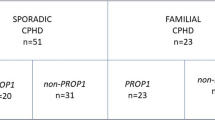Abstract
Acquired PRL deficiency occurs when the anterior pituitary is functionally destroyed, and it usually accompanies other pituitary hormone deficiencies. We retrospectively investigated in an outpatient endocrine clinic of a major tertiary medical center the prevalence and clinical characteristics of acquired PRL deficiency in patients with diseases of the hypothalamic-pituitary axis. The study included 100 consecutive patients, 61 men and 39 women, aged 4–79 yr at diagnosis. Patients were divided by PRL level to normal (>5 ng/ml), mild (3–5 ng/ml), and severe deficiency (<3 ng/ml). Twenty-seven patients (27%) had PRL deficiency, 13 mild deficiency and 14 severe deficiency. Patients with severe PRL deficiency tend to be younger at diagnosis (mean age, 37.5±21.8 yr) than patients with normal PRL (46±18.5 yr; ns). Underlying diseases including pituitary apoplexy, non-functioning pituitary adenoma, craniopharyngioma, and idiopathic hypogonadotropic hypogonadism were associated with PRL deficiency. The incidence of severe PRL deficiency rose with an increase in the number of other pituitary hormone deficits (ACTH, TSH, gonadotropin, vasopressin), from 0 in patients with no other deficits to 38% in patients with 4 deficits (p=0.006). Patients with severe deficiency had a mean of 3 hormone deficits compared to 1.8 in the other groups (p=0.006). PRL deficiency was significantly associated with TSH, ACTH and GH deficiency. Conclusions: PRL deficiency is common in patients with hypothalamic-pituitary disorders, especially pituitary apoplexy and craniopharyngioma. Acquired severe PRL deficiency can be considered a marker for extensive pituitary damage and a more severe degree of hypopituitarism.
Similar content being viewed by others
References
Bole-Feysot C, Goffin V, Edery M, Binart N, Kelly PA. Prolactin (PRL) and its receptor: actions, signal transduction pathways and phenotypes observed in PRL receptor knockout mice. Endocr Rev 1998, 19: 225–68.
Tatsumi K, Miyai K, Notomi T, et al. Cretinism with combined hormone deficiency caused by a mutation in the PIT1 gene. Nat Genet 1992, 1: 56–8.
Radovick S, Nations M, Du Y, Berg LA, Weintraub BD, Wondisford FE. A mutation in the POU-homeodomain if Pit-1 responsible for combined pituitary hormone deficiency. Science 1992, 257: 1115–8.
Pfaffle RW, DiMattia GE, Parks JS, et al. Mutation of the POU-specific domain of Pit-1 and hypopituitarism without pituitary hypoplasia. Science 1992, 257: 1118–21.
Pellegrini-Bouiller I, Belicar P, Barlier A, et al. A new mutation of the gene encoding the transcription factor Pit-1 is responsible for combined pituitary hormone deficiency. J Clin Endocrinol Metab 1996, 81: 2790–6.
Pfaffle RW, Blankenstein O, Wuller S, Kentrup H. Combined pituitary hormone deficiency: role of Pit-1 and Prop-1. Acta Paediatr Suppl 1999, 88: 33–41.
Turton JP, Reynaud R, Mehta A, et al. Novel mutations within the POU1F1 gene associated with variable combined pituitary hormone deficiency. J Clin Endocrinol Metab 2005, 90: 4762–70.
Asteria C, Oliveira JH, Abucham J, Beck-Peccoz P. Central hypocortisolism as part of combined pituitary hormone deficiency due to mutations of PROP-1 gene. Eur J Endocrinol 2000, 143: 347–52.
Rodriguez R, Andersen B. Cellular determination in the anterior pituitary gland: PIT-1 and PROP-1 mutations as causes of human combined pituitary hormone deficiency. Minerva Endocrinol 2003, 28: 123–33.
Vance ML. Hypopituitarism. N Engl J Med 1994, 330: 1651–62.
Mukherjee A, Murray RD, Columb B, Gleeson HK, Shalet SM. Acquired prolactin deficiency indicates severe hypopituitarism in patients with disease of the hypothalamic-pituitary axis. Clinical Endocrinol (Oxf) 2003, 59: 743–8.
Kauppila A, Chatelain P, Kirkinen P, Kivinen S, Ruokonen A. Isolated prolactin deficiency in a woman with puerperal alactogenesis. J Clin Endocrinol Metab 1987, 64: 309–12.
Falk RJ. Isolated prolactin deficiency: a case report. Fertil Steril 1992, 58: 1060–2.
Zargar AH, Masoodi SR, Laway BA, Shah NA, Salahudin M. Familial puerperal alactogenesis: possibility of a genetically transmitted isolated prolactin deficiency. Br J Obstet Gynaecol 1997, 104: 629–31.
Douchi T, Nakae M, Yamamoto S, Iwamoto I, Oki T, Nagata Y. A woman with isolated prolactin deficiency. Acta Obstet Gynecol Scand 2001, 80: 368–70.
Ozbey N, Inanc S, Aral F, et al. Clinical and laboratory evaluation of 40 patients with Sheehan’s syndrome. Isr J Med Sci 1994, 30: 826–9.
Sert M, Tetiker T, Kirim S, Kocak M. Clinical report of 28 patients with Sheehan’s syndrome. Endocr J 2003, 50: 297–301.
Ben-Jonathan N, Mershon JL, Allen DL, Steinmetz RW. Extrapituitary prolactin: distribution, regulation, functions, and clinical aspects. Endocr Rev 1996, 17: 639–69.
Lahat N, Miller A, Shtiller R, Touby E. Differential effects of prolactin upon activation and differentiation of human B lymphocytes. J Neuroimmunol 1993, 47: 35–40.
Walker SE, Allen SH, Hoffman RW, McMurray RW. Prolactin: a stimulator of disease activity in systemic lupus erythematosus. Lupus 1995, 4: 3–9.
Sassolas G, Borson-Chazot F, Jaquet P, et al. GH deficiency in adults: an epidemiological approach. Eur J Endocrinol 1999, 141: 595–600.
Mukherjee A, Murray RD, Teasdale GM, Shalet SM. Acquired prolactin deficiency (APD) after treatment for Cushing’s disease is a reliable marker of irreversible severe GHD but does not reflect disease status. Clin Endocrinol (Oxf) 2004, 60: 476–83.
Mukherjee A, Ryder WDJ, Jostel A, Shalet SM. Prolactin deficiency is independently associated with reduced insulin-like growth factor I status in severely growth hormone-deficient adults. J Clin Endocrinol Metab 2006, 91: 2520–5.
Zayour DH, Selman WR, Arafah BM. Extreme elevation of intrasellar pressure in patients with pituitary tumor apoplexy: Relation to pituitary function. J Clin Endocrinol Metab 2004, 89: 5649–54.
Arafah BM, Prunty D, Ybarra J, Hlavin ML, Selman WR. The dominant role of increased intrasellar pressure in the pathogenesis of hypopituitarism, hyperprolactinemia, and headaches in patients with pituitary adenomas. J Clin Endocrinol Metab 2000, 85: 1789–93.
Author information
Authors and Affiliations
Corresponding author
Rights and permissions
About this article
Cite this article
Toledano, Y., Lubetsky, A. & Shimon, I. Acquired prolactin deficiency in patients with disorders of the hypothalamic-pituitary axis. J Endocrinol Invest 30, 268–273 (2007). https://doi.org/10.1007/BF03346292
Accepted:
Published:
Issue Date:
DOI: https://doi.org/10.1007/BF03346292



